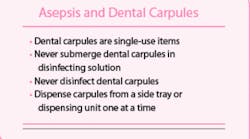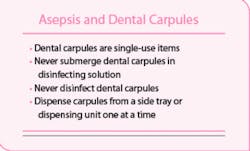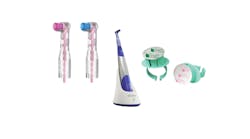by Noel Kelsch, RDHAP
I love delivering anesthesia; it is science at its finest. Good delivery can be the difference between a patient who is comfortable in the dental setting and one who is too phobic to receive treatment. It is an amazing task we are asked to perform. Each time I deliver anesthesia, I am astonished. I render nerves helpless and nonfunctional, literally suspending them for a point in time so that they cannot receive the message of pain. Done correctly, this procedure allows the patient comfort during a time that can be excruciatingly painful. The patient is then restored to a state of full function through the miracle of metabolism in just a few hours. Done incorrectly, it can cause damage to the patient or risk a life.
One part of the delivery of anesthesia that is so simple and yet so complex is the infection control techniques of dental carpules. Dental carpules are small, cylindrical glass tubes often covered with a plastic coating that were designed to maintain and deliver dental anesthetics. These tubes have a plunger to aid in delivery and an aluminum gasket holding a diaphragm in place. This diaphragm was designed to be semipermeable to aid in insertion of the needle used in delivery and yet keep the solution free from contaminants.
Dental carpules are single–use items that were designed to be used by one patient and then disposed of. They were never designed to be disinfected and reused. There are many design flaws that would never allow them to be reusable items.
Dr. Daniel Haas stated in his article "Localized Complications From Local Anesthesia": "Even though the anesthetic cartridge was not used, it must be considered contaminated and should be disposed of. Since disinfectants can diffuse through the diaphragm and contaminate the anesthetic solution, do not store or submerge cartridges in these agents. Instead, anesthetic cartridges should be dispensed using the concept of unit dose measurement to prevent contamination of unused supplies." 1
Administration of local anesthetic from a cartridge contaminated by alcohol or sterilizing solution may induce paresthesia2 Neurotoxicity may be a factor, since a review of the literature suggests that local anesthetics have this potential.3–8 Cartridges stored in a disinfecting solution such as alcohol may have residual amounts of solution on the end of the cartridge, or solution may have diffused into the cartridge through the semipermeable diaphragm that can then be administered inadvertently during injection.
Dental professionals need to remember what single use means. Once a single–use item hits the tray, it is finished! There is no taking it back. It belongs to the patient and may not be sanitized or sterilized. Reusing carpules that have been placed on a patient delivery care tray creates the risk of cross contamination and the spread of diseases from patient to patient. It is the dental care provider’s responsibility to keep the patient out of harm’s way. It is much more practical and cost–effective to dispense the carpules one at a time to avoid having to discard unused ones. The simple solution to this dilemma is to dispense the carpules one at a time on a side tray with a cover. Many companies have developed holders designed to dispense one at a time with no cross contamination.
There are many things that dental professionals are asked to do to help their patients stay comfortable and safe. It is "do no harm" at its finest when we do not allow single–use items to be reused and when we take our patients’ health and safety as our first concern. Knowledge of simple things, such as dental carpules, and complex tasks, such as asepsis procedures, can and does make a difference in our patients’ health and lives.
Stay tuned for Part Two: "Phone Calls to 50 States: Disposing of Dental Carpules."
About the Author
Noel Brandon Kelsch, RDHAP, is a freelance cartoonist, writer, and speaker. Noel’s cartoons can be seen in RDH magazine and her articles have been published in both dental and nursing trade magazines, as well as books. She has received many national awards including Colgate Bright Smiles Bright Futures, RDH/Sunstar Butler Award of Distinction, USA magazine Make a Difference Day award, President’s Service award, Foster Parent of the Year, and is a five–time winner of the Castroville (Calif.) Artichoke cook–off! Her family lives in Moorpark, Calif. She can be contacted at [email protected].
References
1 Haas DA. Localized complications from local anesthesia. Journal of the California Dental Association 1998.
2 Shannon IL, Wescott WB. Alcohol contamination of local anesthetic cartridges. J Acad Gen Dent 1974; 22:20–21.
3 Steen PA, Michenfelder JD. Neurotoxicity of anesthetics. Anesthesiology 1979; 50:437–453.
4 Myers RR, Kalichman MW, et al. Neurotoxicity of local anesthetics: altered perineurial permeability, edema, and nerve fiber injury. Anesthesiology 1986; 64:29–35.
5 Kalichman MW, Moorhouse DF, et al. Relative neural toxicity of local anesthetics. J Neuropathol Exp Neurol 1993; 52:234–240.
6 Rigler ML, Drasner K, et al. Cauda equina syndrome after continuous spinal anesthesia. Anesth Analg 1991; 72:275–281.
7 Lambert DH, Hurley RJ. Cauda equina syndrome and continuous spinal anesthesia. Anesth Analg 1991; 72:817–819.
8 Barsa J, Batra M, et al. A comparative in vivo study of local neurotoxicity of lidocaine, bupivacaine, 2–chloroprocaine, and a mixture of 2–chloroprocaine and bupivacaine. Anesth Analg 1982; 61:961–967.







